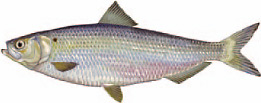Blueback herring
Life History

- Overall silvery color, usually with bluish green coloration on top
- Eye diameter less than or equal to snout length
- Abdomen with sharp scutes forming distinct keel
- Minute teeth present at front of jaws (disappearing with age)
- Usually one small dark spot located on the upper side of the body just behind the gill plate (often absent in fish less than 10 cm TL)
- Peritoneum (inside lining of the abdominal cavity) is black or dusky
- Reach a maximum length of about 38 cm (15in.)
Range from Cape Breton, Nova Scotia to St. Johns Bay, Florida. Peak spawning in Virginia occurs from April through May when water temperatures are 21 to 24° C. Blueback herring prefer to spawn in swift-flowing deeper stretches of river and streams with associated hard substrate. Spawning also occurs in areas covered in vegetation, swampy areas and in small tributaries upstream from the tidal zone. Females can release between 46,000 to 350,000 eggs per season. Once fertilized, the eggs usually hatch within 2-3 days. Juveniles will spend their first summer in freshwater. With the approach of cooling water temperatures in the fall, most juvenile blueback herring will begin their seaward migration. Some will overwinter in the deep waters of the bay and its tributaries. Blueback herring feed on zooplankton (i.e. copepods), small fishes and shrimp. Blueback herring are vertical migrators: following the diel movements of zooplankton in the water column. However, blueback herring are typically found higher in the water column than alewives. This possibly reduces feeding competition between the two species. After spawning, blueback herring form schools and migrate offshore to overwinter near the bottom. Blueback herring will not return to freshwater until reaching sexual maturity between 3-5 years of age.
